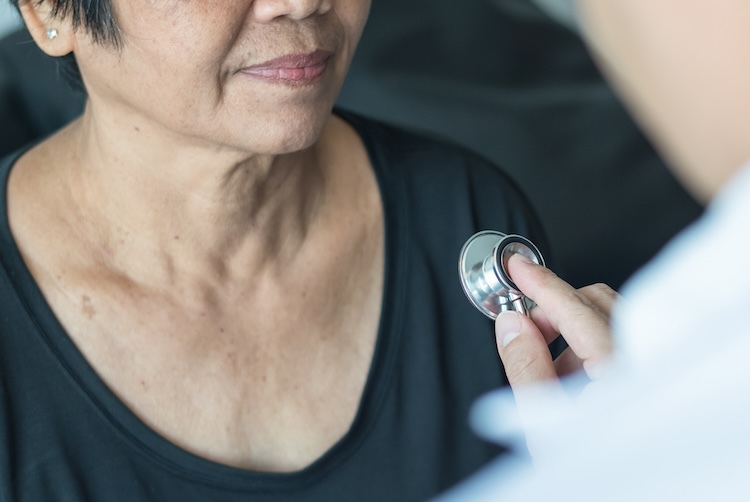
What women need to know about heart disease
With atypical symptoms, women often dismiss their heart disease symptoms and wait to seek medical care, VCU Health Pauley Heart Center expert says.
February 29, 2024
 In 2021, heart disease was the leading cause of death for adults in the United States. (Getty Images)
In 2021, heart disease was the leading cause of death for adults in the United States. (Getty Images)
By Mia Stephens
The heart is a strong but delicate organ. About the size of a fist, it helps orchestrate the rest of the body’s functions by pumping blood.
However, diseases that effect the heart’s functions were responsible for the deaths of one in every four men and one in every five women in the United States in 2021 – making it the number-one killer of men and women. In 2021, 16,654 Virginians died from heart disease, making it the leading cause of death in the commonwealth followed by cancer and COVID-19.
While the Centers for Disease Control and Prevention notes that more than 60 million women in the U.S. are living with some form of heart disease, but only half are aware that heart disease is the leading cause of death for women nationwide.
"Knowledge is power... It is crucial for women to partner with their health care providers to pinpoint what heart-related conditions they have and how to fix them,” said Hem Bhardwaj, M.D., who specializes in imaging and critical care cardiology at the VCU Health Pauley Heart Center. “Heart disease has an impact on everybody’s life. It’s not just you, it’s a family member or a close friend.”
As she has taken care of patients over the years, Bhardwaj has seen women become more aware about the signs, symptoms and risks to heart-related illnesses – the vast majority of which can be prevented.
Many of us are familiar with the “textbook” symptoms of a heart issue, like chest pain and shortness of breath. However, women sometimes experience milder symptoms, such as weakness, fatigue and indigestion. Other biological factors contribute to the development of heart disease differently in women compared to men. Pregnancy, for example, can put a strain on the heart. Women’s arteries also are smaller and narrower, which can lead to more buildup.
Bhardwaj spoke with VCU Health News to share some of the ways in which women develop and experience heart disease differently than men, and guidance for keeping your heart healthy, no matter your gender identity.
What is heart disease and how does it develop?
Heart disease is a disease that affects the heart or heart vessels. The most common form of heart disease in women (and all adults) is coronary artery disease (CAD), which develops when plaque builds on the walls of the arteries, known as atherosclerosis. But there are many other forms of heart disease beyond CAD; the most common in women are arrhythmia (irregular heartbeat) and heart failure, according to the Centers for Disease Control and Prevention (CDC). Heart disease can be caused by a wide variety of factors—some of the most common are high blood pressure, smoking, and an inactive lifestyle. Other factors that might spark heart-related risks include high cholesterol levels, diabetes, and metabolic syndrome, which is a combination of health conditions that occur together.
What heart-related symptoms do you see more often in your patients who are women than patients who are men?
Heart disease is the number-one killer of men and women. However, women often present with symptoms different than men, and usually later with more complications. Sometimes women experience symptoms such as weakness, fatigue, shortness of breath and jaw pain, not the classic chest pain with radiation to the left arm that you often see with men. Hormonal changes in women after menopause can be a factor. Another example: both men and women are commonly diagnosed with coronary artery disease, but women tend to experience it after menopause because of hormonal changes.
Heart disease can affect women at any age. What age ranges are heart-related diagnoses most common?
Heart disease is an equal-opportunity killer. I have seen women as young as their late teens all the way to their 90s who have heart disease. Heart disease affects so many lives across many ranges — age, sex, ethnicities and so much more.
Studies cited by the American Heart Association show that around 58% of African American women and 42% of white, Hispanic and Asian women experience some form of heart disease.
Are there any biological contributors that may make women more susceptible to heart-related conditions compared to men?
There is continuous research examining hormonal differences as a major indicator for the differences between men and women’s hearts. However, women are often underrepresented in clinical trials that analyze sex-specific differences in the heart. Despite the low participation, research is still ongoing. Another biological contributor to note is the location of plaque buildup within the arteries. Men tend to develop buildup in the larger arteries, while women experience it in the smaller ones. Even though cholesterol partially affects the development of heart disease, it is important to be mindful of any inflammation that occurs.
Biological events such as pregnancy can trigger heart disease if not properly monitored. Studies show that less than half of women entering pregnancy in the U.S., have optimal heart health. This is crucial for new moms to be aware of, and to discuss with their pregnancy care provider. In addition to pregnancy, women diagnosed with endometriosis under the age of 40 have higher chance of developing a coronary heart disease compared to women without endometriosis.
Are there any external factors that play a role in contributing to heart-related illnesses specifically in women?
Stress is a big contributor to heart disease. For women, stress can cause them to not recognize abnormal symptoms when they happen. This leads to delayed diagnosis or even death if not caught in time. Other factors include not exercising, poor diet, smoking, and the existence of other medical conditions.
Besides lifestyle factors, beliefs and attitudes also play a role. Studies show that women are less likely to receive CPR from a bystander in a heart-related emergency as opposed to men. This creates a survival gap between men and women of 23%.
How can I tell if something might be wrong or irregular with my heart?
You might notice slight changes in your usual activity level, or what I call your baseline activity or functional capacity. You should monitor any changes in your breathing or energy levels.
If you’re experiencing a symptom that isn’t typical, but it does not prevent you from doing routine activities, contact your primary care provider or cardiologist, if you have one.
To illustrate this, I had one patient who told me that her normal activity was walking her dog about a mile every day, but she was beginning to find that difficult over the past few months. She was finding it difficult to even walk half a mile. She’s not a marathon runner, but everyone has a certain level of activity they can pinpoint that they do now or that they can’t do anymore. It turns out, this patient had a major blockage in one of the arteries in her heart. Once we fixed that, she was able to get back to walking her dog a mile a day.
At what point should someone seek medical advice for heart problems?
Women can present differently than men when it comes to heart-related emergencies, especially women who are older or with diabetes. If you or a loved one are experiencing the following symptoms, the CDC recommends you call 9-1-1.
- Heart attack (including but not limited to): Chest pain, neck pain, indigestion, heartburn, nausea or vomiting, extreme fatigue, dizziness, and shortness of breath
- Fluttering feelings in the chest (palpitations)
- Sudden fatigue
- Swelling of the feet, ankles, legs or abdomen
Women sometimes ignore these symptoms because they don’t realize they could be having a heart attack – they think it’s something else, such as heartburn. There are also instances where women come into the hospital thinking they’re experiencing a heart attack, but it’s something else, like a coronary spasm.
Overall, if your symptoms are so significant that it sort of stops you in your track, you need to go to the emergency room. What I tell patients is that if you feel any symptom that is not typical – you need to go see your doctor because you don’t know what it is and you’re not a doctor.
What does treatment look like for heart disease?
Treatment options vary depending on the specific heart condition. Patients who have comorbidities, which means they have one or more medical conditions, such as diabetes, high blood pressure, or high cholesterol, are advised to get regular lab work done to reduce chances of developing heart disease.
Other treatment options include partnering up with your care team to identify ways to create a healthy lifestyle or regimen as part of prevention efforts. For some, medication may be a temporary or long-term solution. For others, that means larger lifestyle changes or a combination of both.
Family history also plays a role in this, so be sure to track down any family medical history information available to share with your provider.



